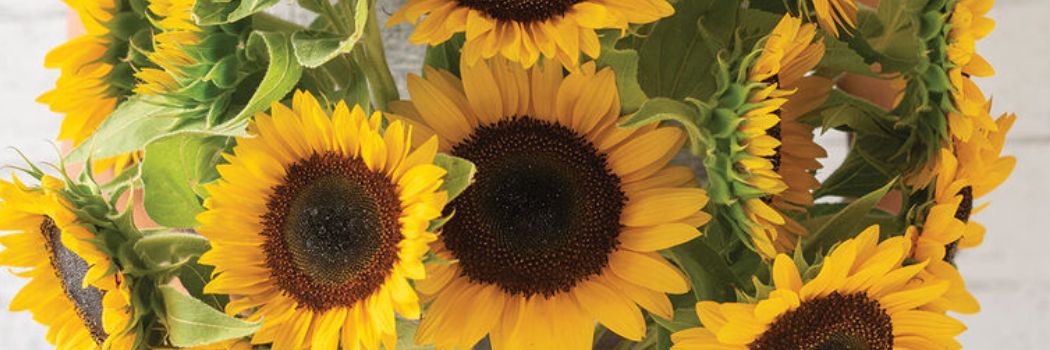- 3 Easy, Reliable, Productive Cut Flowers: Sunflowers, Zinnias & Rudbeckia
- 5 Factors That Determine Vase Life of Cut Flowers
- 2019 American Flowers Week: Combining the Art of Floral Design & Couture
- Celebrate the 7th American Flowers Week | Johnny's 2021 Botanical Couture
- Celebrating the 8th American Flowers Week | Johnny's 2022 Botanical Couture
- Collective Selling Models for Flower Farmers: Flower Hubs That Work
- 5 Cool Flowers to Plant Now | Lisa Mason Ziegler's Secrets for Growing Hardy, Cool-Season Annuals
- Cut-Flower Harvesting & Post-Harvest Care | Best Practices from Pros in the Slow Flower Community
- Cut-Flower Kit | Guide for Market Growers (PDF)
- Easy Cut-Flower Garden Map | For Growers New to Flowers (PDF)
- Easy Cut-Flower Garden Planner | For Growers New to Flowers (PDF)
- From Color to Climate: 5 Floricultural Trends Subtle & Seismic
- Flower Culture by Crop | Comparison Chart | Days to Germination, Weeks to Transplant, Days to Harvest (PDF)
- Flower Farmers' Favorite Fillers & Foliage | Recommendations from 3 Farmer-Florists
- Getting Started in Cut-Flowers | Top 15 Cuts
- Heat & Drought: How Flower Farmers Are Adapting to Changing & Challenging Climatic Conditions
- Introduction to Overwintering Flowers | Guide to Overwintering Flowers
- An Introduction to Producer Marketing Cooperatives | M Lund & Associates
- How Day Length Affects Cut-Flower Production
- Growing Flowers in Hoophouses & High Tunnels: Cool-Weather & Hot-Weather Options
- Starting a U-Pick Flower Farm, From A-to-Z
- Growing Flower Seedlings for Profit
- Roadside Flower Stand Basics: Success Tips for On-Farm Retail
- Year-Round Flower Production Strategy
- Overwinter Flower Trials | Multiyear Results for 30+ Crops | Johnny's Selected Seeds | XLSX
- Seeding Date Calculator | Johnny's Recommended Flowers for Overwintering | XLSX
- Pricing & Profitability for Flower-Farmers | Pointers from a Diversity of Pros
- Sustainable Farming Methods | A Survey of Flower Farmers' Best Practices
- Just Add Flowers | An Introduction to Companion Planting for Vegetable & Herb Gardeners
- Slow Flowers Palette & Petal Crushes | Evolving Colors & Shape-Shifts in Floral Industry Trends
- Johnny's and Slow Flowers | Johnny's Selected Seeds
- Slow Flowers | Celebrating Fifth-Season Regional Design Elements
- Slow Flowers Floral Forecast | A Summary of Industry Insights & Trends
- Building a Better Market Bouquet: Tips, Techniques & Recipes for Flower Farmers
- Slow Flowers | Tips for Staging On-Farm Floral Workshops | Johnny's Selected Seeds
- Wedding Wisdom 101 | 10 Beginner Tips for Entering the Wedding Floral Landscape
- Succession-Planting Flowers | Scheduling & Planning, Sowing Frequency, Recordkeeping & Recommendations
- Succession-Planting Interval Chart for Flowers
- Sustainable Floral Design | Techniques & Mechanics for Foam-Free Floristry | Tobey Nelson & Debra Prinzing
- Video: Mason Jar Bouquet Tutorial
- Video: How to Build a Bouquet
- Video: Tobey Nelson | Sustainable Floral Design | Slow Flowers Summit
- Video: Economic Considerations in Overwintering Cut Flowers | Johnny's Selected Seeds
- Top 10 Cut-Flower Varieties for Direct Seeding
- Video: Floating Row Cover | Baby "Cool Flower" Protection from Whipping Winter Winds
- Video: The Procona System for All-in-one Flower Harvest, Transport & Display
- Johnny's Overwinter Flowers Tunnel: Trellising, Supports, Ground Cover & Spacing
- Video: Irrigation Considerations for the Overwinter Flowers Tunnel | Johnny's Selected Seeds
- Video: Johnny's Overwinter Flowers Trial Recap
- Video: Producer Cooperatives for Small-Scale Farmers | Johnny's Webinar Series
- Climate Adaptation for Vegetable & Flower Farmers | Johnny's Educational Webinar Resources
- Chrysal CVBN Flower Conditioner | SDS
- Webinar Slide Deck | New-for-2023 Flowers & Floral Supplies | PDF
- Chrysal Clear Bulb Flower Conditioner | SDS
- Chrysal Professional 2 Transport & Display T-Bag | SDS
- Chrysal Classic Professional 2 Transport & Display (Holding) Solution | SDS
- Chrysal Clear Universal Flower Conditioner | SDS
- Webinar Slide Deck | Flower Growing in Southern States | PDF
- Choosing Flower Crops to Overwinter | Guide to Overwintering Flowers
- Edible Flowers List: Top 20 Favorites from the Slow Flowers Community
- Floral Standards for Flower Farm Collectives and Cooperatives
- Bloom to Boom: Flower Farm Profitability
- Choosing Tulip Varieties for Forcing | Guide to Forcing Flower Bulbs
- Forcing Tulip Bulbs | Guide to Forcing Flower Bulbs
- Snapdragon Groups Explained
- Flowering in the South: Profiles of 5 flower farmers who cope with temperature, humidity, pest & weed pressure
- Video: Flower Growing in Southern States | Johnny's Webinar Series
- 10 Tips for Building a Profitable Cut-Flower Business
- Introduction to Forcing Flower Bulbs in Soil | Guide to Forcing Flower Bulbs
- U-Pick Power for Your Flower Farm | Johnny's Webinar Series
- Eat Your Flowers: Serve Up That Wow Factor With Edible Flowers
- U-Pick Power for Your Flower Farm | Johnny's Webinar Series
- Flower Growing in Southern States | Johnny's Educational Webinar Series
- Chrysal Clear Bulb T-Bag | Cut-Flower Conditioner | SDS
- Chrysal Professional 1 Hydration Solution | SDS
- Chrysal Professional 3 Vase Solution Powder | SDS
- When to Start Seeds for Overwintered Flowers | Guide to Overwintering Flowers
- Webinar Slide Deck | U-Pick Power for Your Flower Farm | PDF
by Lynn Byczynski, Author & Founder of Growing for Market

Lynn Byczynski was growing organic vegetables and cut flowers for market when she decided to create a magazine that would help market gardeners nationwide share experiences and information. Her first issue of Growing for Market appeared in January 1992, and GFM has been published continuously ever since, becoming renowned in the market-gardening world for realistic articles that provide practical, how-to information about growing and selling produce and flowers.
Darkness & Light
Light is a huge factor influencing the growth and blooming of flowering plants, so it's essential for flower and bedding plant growers to understand its effects.
Regarding the relationship of light to blooming and growth of flowering plants, the first thing to recognize is that the emphasis on day length is somewhat misguided. Scientific research has confirmed that it is the length of darkness rather than daylight that acts as the primary driver of plant growth and blossoming. But because this fact was discovered long after day length became widely used in horticulture, the misperception has stuck around. Botanists and many horticulturists now prefer to use the term photoperiodism instead, to describe the response of plants to the relative lengths of light and dark periods to which they're exposed.
Terminology aside, simply recognizing the importance of dark periods can come in handy for the grower, because it can be used to induce plants to bloom outside their normal season. (More on that below.)
Long-Day Plants, Short-Day Plants, Day-Neutral Plants
Many plant species have day-length triggers that determine when they grow vegetatively and when they initiate bloom. Plants that flower when the days are longer than 12 hours are referred to as long-day plants, and those that flower when days are less than 12 hours long are called short-day plants. Those that don't respond to day length are called day-neutral.
Summer flowers are often long-day species, so they won't bloom in winter even if you were to plant them in a tropical greenhouse. Rudbeckia 'Indian Summer' is a good example. It grows vegetatively when days are short and then, when days reach a certain length, it sends up tall flower stems. Plant it in spring, and you'll get a great crop in summer. But if you plant it in summer, hoping for a fall crop, you will be disappointed. The plants will grow nicely, as the days get shorter, but they won't flower — or if they do, it will be on short stems. They simply need longer days to produce long-stemmed flowers.
Many other cut-flower varieties are either long-day or short-day plants. Most sunflower varieties, for example, are long-day species that will grow vegetatively during the short days of spring, then bloom when the days reach a specific length. If you want to grow sunflowers in early spring or late fall, when days are short, you need to plant day-length-neutral varieties.
Night Interruption (NI) and Day Extension (DE) Lighting
Greenhouse and other protected-culture growers use supplemental lighting to get around the day-length requirements of flowering crops. To create a long-day (LD) photoperiod, you can use one of two methods:
- You may turn on lights shortly before sunset to extend the length of the light period. This is called day-extension (DE) photoperiod lighting.
- Or, you may turn on the lights during the middle of the night for a short period of time, a procedure called night interruption (NI) lighting.
Both bring us back to the fact that it's the dark period that's important to plants: The short days of winter have long nights. If a grower shortens the night by turning lights on toward dusk (DE), or breaks up those long nights by turning on lights in the middle of the night (NI), some plants will act as though the night is short (and therefore the day is long) and behave just as they would in the middle of summer. Many bedding plant and cut-flower greenhouses use NI or DE lighting to force flowers to bloom in the off seasons.
Light-Dark Rhythms at Your Latitude
Naturally, there are many other variables that play a role in the transition between vegetative growth and reproduction cycles in flowering plants, but light is predominant for many if not most crops.
With day length playing such a big role in flower production, it's smart to get acquainted with the day–night cycles at your location during each month. Get a sunrise/sunset calculator or add one to your calendar with ticklers to remind you on dates when you have 10 hours of daylight, 11 hours, 13 hours, and so on.
Over time, you will begin to note correlations between day length and flowering plant lifecycles, which will enable you to find ways to enhance the health and productivity of your flowering crops and plants.


